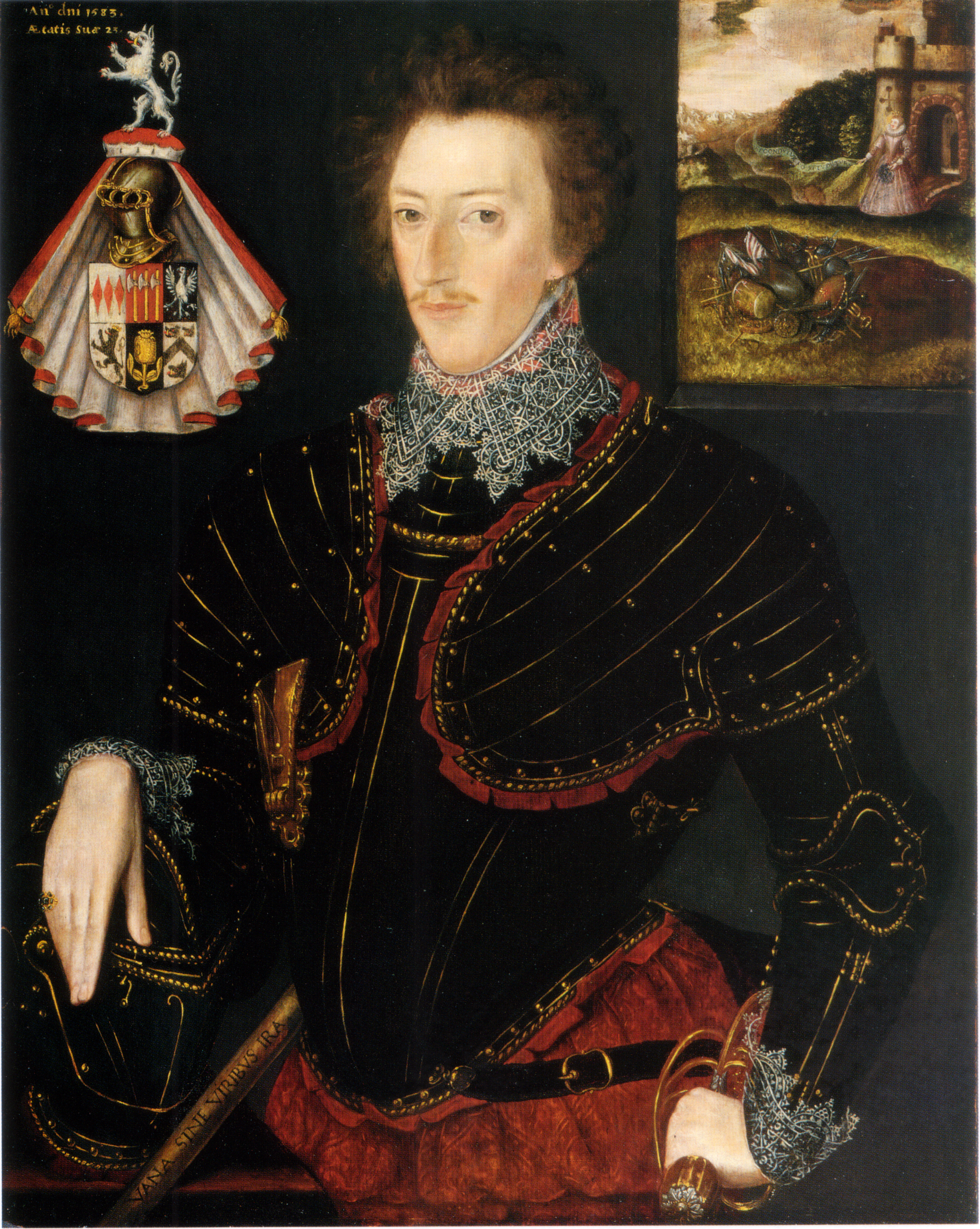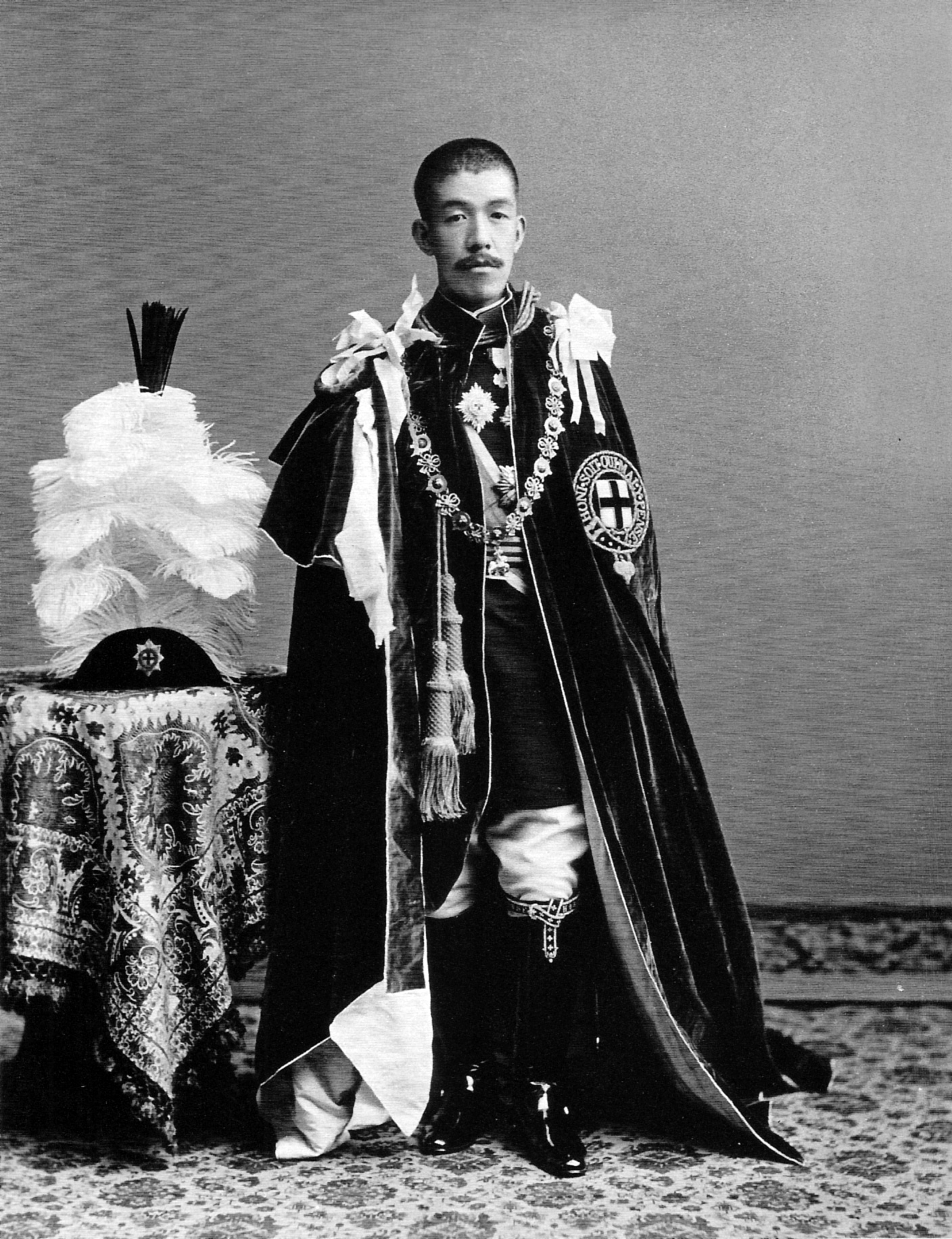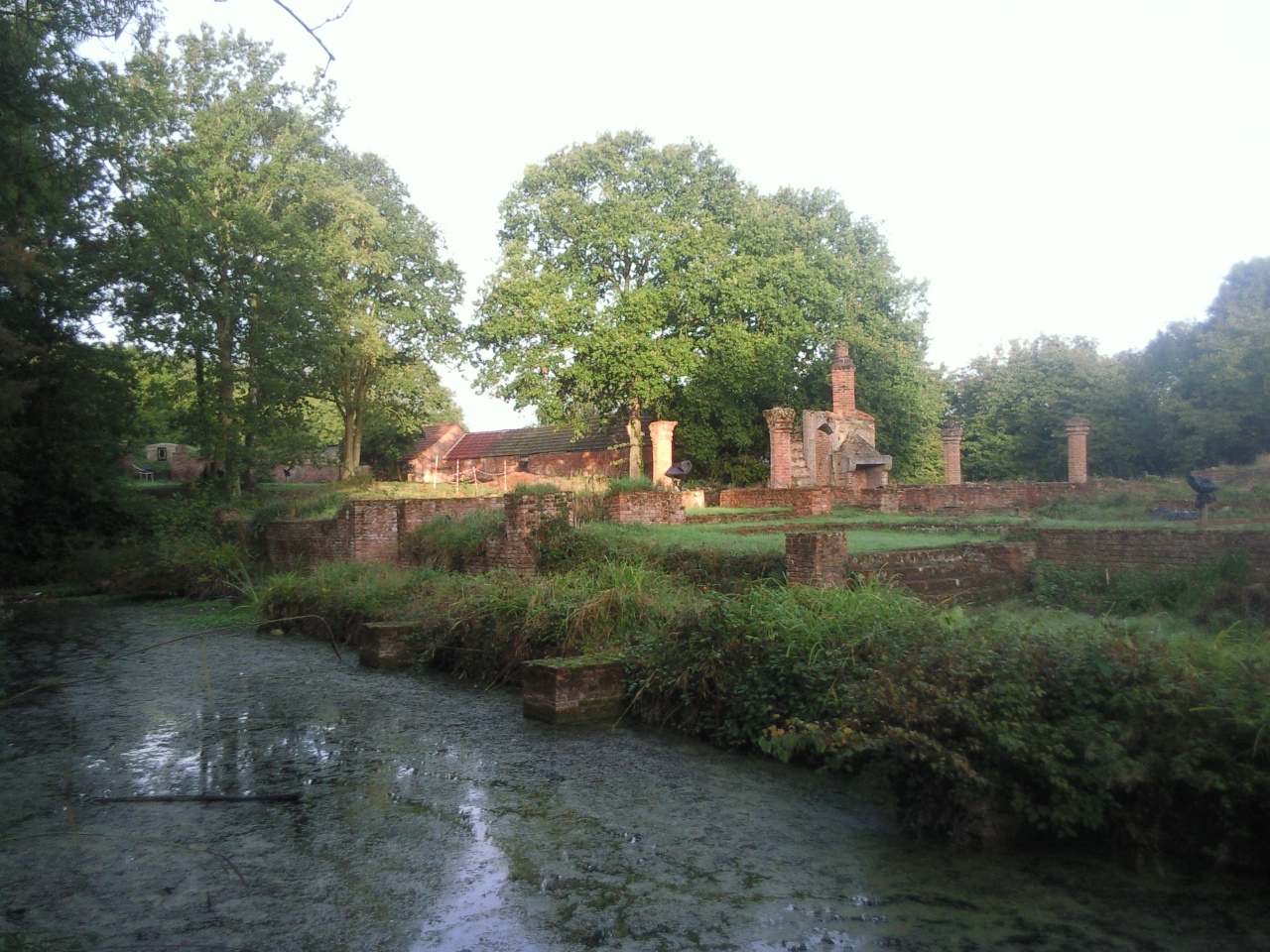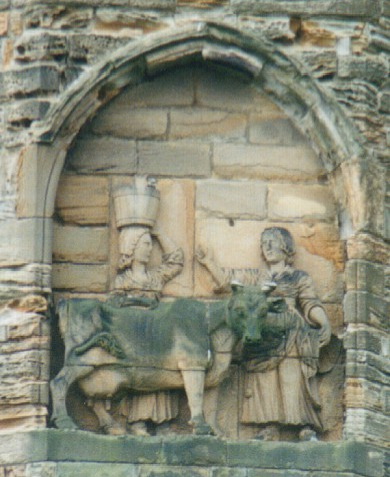|
Edward Hoby
Sir Edward Hoby (1560 – 1 March 1617) was an English diplomat, Member of Parliament, scholar, and soldier during the reigns of Elizabeth I and James I. He was the son of Thomas Hoby and Elizabeth Cooke, the nephew of William Cecil, Lord Burghley, and the son-in-law of Queen Elizabeth's cousin Henry Carey, 1st Baron Hunsdon. A favourite of King James, Hoby published several works supporting the Protestant cause as well as translations from French and Spanish. His heir was his illegitimate son, Peregrine Hoby. Biography Born at Bisham Abbey, Berkshire, in 1560, Edward Hoby was the eldest son of Sir Thomas Hoby and his wife Elizabeth, third daughter of Sir Anthony Cooke or Coke of Gidea Hall, Essex. He was educated at Eton, where he formed a lasting friendship with Sir John Harington, and at Trinity College, Oxford. At Trinity Thomas Lodge, who later became a dramatist, was "servitor or scholar" under him. Under the auspices of his uncle, Lord Burghley, he rose into high ... [...More Info...] [...Related Items...] OR: [Wikipedia] [Google] [Baidu] |
Sir Edward Hoby 1583
''Sir'' is a formal honorific address in English for men, derived from Sire in the High Middle Ages. Both are derived from the old French "" (Lord), brought to England by the French-speaking Normans, and which now exist in French only as part of "", with the equivalent "My Lord" in English. Traditionally, as governed by law and custom, Sir is used for men who are knights and belong to certain orders of chivalry, as well as later applied to baronets and other offices. As the female equivalent for knighthood is damehood, the ''suo jure'' female equivalent term is typically Dame. The wife of a knight or baronet tends to be addressed as Lady, although a few exceptions and interchanges of these uses exist. Additionally, since the late modern period, Sir has been used as a respectful way to address a man of superior social status or military rank. Equivalent terms of address for women are Madam (shortened to Ma'am), in addition to social honorifics such as Mrs, Ms, or Miss. Etym ... [...More Info...] [...Related Items...] OR: [Wikipedia] [Google] [Baidu] |
Thomas Lodge
Thomas Lodge (September 1625) was an English writer and medical practitioner whose life spanned the Elizabethan and Jacobean periods. Biography Early life Thomas Lodge was born about 1557 in West Ham, the second son of Sir Thomas Lodge, Lord Mayor of London, by his third wife Anne (1528–1579), daughter of Henry Luddington (died 1531), a London grocer. The year before he was born his father had transferred the ownership the manors of Hawkstone and Soulton to Sir Rowland Hill, publisher of the Geneva Bible and a fellow Lord Mayor. The Lodge family continued some form of association with those manors, and it has been suggested that this was part of the inspiration of Lodge junior's literary output. He was educated at Merchant Taylors' School and Trinity College, Oxford; taking his BA in 1577 and MA in 1581. In 1578 he entered Lincoln's Inn, where, as in the other Inns of Court, a love of letters and a crop of debts were common. Early literary work Lodge, dis ... [...More Info...] [...Related Items...] OR: [Wikipedia] [Google] [Baidu] |
Knight Of The Shire
Knight of the shire () was the formal title for a member of parliament (MP) representing a county constituency in the British House of Commons, from its origins in the medieval Parliament of England until the Redistribution of Seats Act 1885 ended the practice of each county (or ''shire'') forming a single constituency. The corresponding titles for other MPs were '' burgess'' in a borough constituency (or ''citizen'' if the borough had city status) and ''baron'' for a Cinque Ports constituency. Knights of the shire had more prestige than burgesses, and sitting burgesses often stood for election for the shire in the hope of increasing their standing in Parliament. The name "knight of the shire" originally implied that the representative had to be a knight, and the writ of election referred to a belted knight until the 19th century; but by the 14th century men who were not knights were commonly elected. An act of Henry VI ( 23 Hen. 6. c. 14) stipulated that those eligible ... [...More Info...] [...Related Items...] OR: [Wikipedia] [Google] [Baidu] |
Spanish Armada
The Spanish Armada (often known as Invincible Armada, or the Enterprise of England, ) was a Spanish fleet that sailed from Lisbon in late May 1588, commanded by Alonso de Guzmán, Duke of Medina Sidonia, an aristocrat without previous naval experience appointed by Philip II of Spain. His orders were to sail up the English Channel, join with the Duke of Parma in Flanders, and escort an invasion force that would land in England and overthrow Elizabeth I. Its purpose was to reinstate Catholicism in England, end support for the Dutch Republic, and prevent attacks by English and Dutch privateers against Spanish interests in the Americas. The Spanish were opposed by an English fleet based in Plymouth. Faster and more manoeuvrable than the larger Spanish galleons, its ships were able to attack the Armada as it sailed up the Channel. Several subordinates advised Medina Sidonia to anchor in the Solent and occupy the Isle of Wight, but he refused to deviate from his instructions to ... [...More Info...] [...Related Items...] OR: [Wikipedia] [Google] [Baidu] |
William Davison (diplomat)
William Davison (21 December 1608) was an English diplomat and secretary to Queen Elizabeth I. As a Secretary of some influence, he was active in forging alliances with England's Protestant friends in Holland and Scotland to prevent war with France. He was involved in the 1587 execution of Mary, Queen of Scots, and was made a scapegoat for this event. Diplomacy According to James Melville of Halhill, Davison claimed to be of Scottish descent. He first visited Scotland acting as secretary to Henry Killigrew, according to an early biographer, in June 1566 when Mary Stuart gave birth to her son in Edinburgh Castle. Davison more certainly came to Edinburgh with Killigrew in 1574 and 1575. Davison was a member of the English Privy Council's Puritan group around Robert Dudley, Earl of Leicester and Francis Walsingham, Elizabeth's principal secretary and spymaster. Between 1576 and 1577, Davison was sent on at least three separate missions to France to attempt to broker peace and p ... [...More Info...] [...Related Items...] OR: [Wikipedia] [Google] [Baidu] |
Francis Walsingham
Sir Francis Walsingham ( – 6 April 1590) was principal secretary to Queen Elizabeth I of England from 20 December 1573 until his death and is popularly remembered as her " spymaster". Born to a well-connected family of gentry, Walsingham attended Cambridge University and travelled in continental Europe before embarking on a career in law at the age of twenty. A committed Protestant, during the reign of the Catholic Queen Mary I of England he joined other expatriates in exile in Switzerland and northern Italy until Mary's death and the accession of her Protestant half-sister, Elizabeth. Walsingham rose from relative obscurity to become one of the small coterie who directed the Elizabethan state, overseeing foreign, domestic and religious policy. He served as English ambassador to France in the early 1570s and witnessed the St. Bartholomew's Day massacre. As principal secretary, he supported exploration, colonisation, the development of the navy, and the plantat ... [...More Info...] [...Related Items...] OR: [Wikipedia] [Google] [Baidu] |
Parliament Of England
The Parliament of England was the legislature of the Kingdom of England from the 13th century until 1707 when it was replaced by the Parliament of Great Britain. Parliament evolved from the Great Council of England, great council of Lords Spiritual, bishops and Peerages in the United Kingdom, peers that advised the History of the English monarchy, English monarch. Great councils were first called Parliaments during the reign of Henry III of England, Henry III (). By this time, the king required Parliament's consent to levy taxation. Originally a Unicameralism, unicameral body, a Bicameralism, bicameral Parliament emerged when its membership was divided into the House of Lords and House of Commons of England, House of Commons, which included Knight of the shire, knights of the shire and Burgess (title), burgesses. During Henry IV of England, Henry IV's reign, the role of Parliament expanded beyond the determination of taxation policy to include the "redress of grievances", whi ... [...More Info...] [...Related Items...] OR: [Wikipedia] [Google] [Baidu] |
Queenborough
Queenborough is a town on the Isle of Sheppey in the Swale borough of Kent in South East England. Queenborough is south of Sheerness. It grew as a port near the Thames Estuary at the westward entrance to the Swale where it joins the River Medway. It is in the Sittingbourne and Sheppey parliamentary constituency. Queenborough Harbour offers moorings between the Thames and Medway. It is possible to land at Queenborough on any tide and there are boat builders and chandlers in the marina. Admiral Lord Nelson is reputed to have learned many of his seafaring skills in these waters, and also shared a house near the small harbour with his mistress, Lady Hamilton. Queenborough today still reflects something of its original 18th-century seafaring history, from which period most of its more prominent buildings survive. The church is the sole surviving feature from the medieval period. The town was first represented by two members of parliament in 1572. History Saxon In Saxon ti ... [...More Info...] [...Related Items...] OR: [Wikipedia] [Google] [Baidu] |
James Stewart, Earl Of Arran
Captain James Stewart, Earl of Arran (died 1595) was created Earl of Arran by the young King James VI, who wrested the title from James Hamilton, 3rd Earl of Arran. He rose to become Lord Chancellor of Scotland and was eventually murdered in 1595. Career He was the second son of Andrew Stewart, 2nd Lord Ochiltree, by his wife Agnes, the daughter of John Cunningham, 5th of Capringtoun, Ayrshire. Stewart's sister, Margaret, was married to the reformer John Knox. In April 1573, James was sent as a "pledge" or hostage to England for the security of the English army and artillery sent to the "Lang Siege" of Edinburgh Castle, which was held by supporters of Mary Queen of Scots. Regent Morton gave him £55 for his expenses in England. He was Captain of the Royal Guard of James VI, served with the Dutch forces in the Netherlands against the Spanish, and returned to Scotland in 1579. James quickly became a favourite of the young king, and in 1580 was made Gentleman of the Bedchamber ... [...More Info...] [...Related Items...] OR: [Wikipedia] [Google] [Baidu] |
Durham, England
Durham ( , locally ) is a cathedral city and civil parish in the county of County Durham, Durham, England. It is the county town and contains the headquarters of Durham County Council, the unitary authority which governs the district of County Durham (district), County Durham. The built-up area had a population of 50,510 at the 2021 Census. The city was built on a meander of the River Wear, which surrounds the centre on three sides and creates a narrow neck on the fourth. The surrounding land is hilly, except along the Wear's floodplain to the north and southeast. Durham was founded in 995 by Anglo-Saxon monks seeking a place safe from Viking Age, Viking raids to house the relics of St Cuthbert. The church the monks built lasted only a century, as it was replaced by the present Durham Cathedral after the Norman Conquest; together with Durham Castle it is a UNESCO World Heritage Site. From the 1070s until 1836 the city was part of the County Palatine of Durham, a semi-independ ... [...More Info...] [...Related Items...] OR: [Wikipedia] [Google] [Baidu] |
Patrick Gray, 6th Lord Gray
Patrick Gray, 6th Lord Gray (died 1612), known most of his life as Patrick, Master of Gray, was a Scottish nobleman and politician during the reigns of Mary, Queen of Scots and James VI of Scotland. Early life Patrick Gray, the son of Patrick Gray, 5th Lord Gray, and of his wife Barbara (a daughter of William Ruthven, 2nd Lord Ruthven) grew up as a Protestant and attended the University of Glasgow. In 1575 he married Elizabeth Lyon, daughter of John Lyon, 8th Lord Glamis, a marriage that failed shortly afterwards. Patrick traveled to France, converted to Roman Catholicism and became a supporter of Mary, Queen of Scots (died 1587). Political life On his return to Scotland in 1583, Patrick gained notability as a political schemer and diplomat, endearing himself to the young King James whilst he plotted with James Stewart, Earl of Arran to keep Mary in prison and frustate Mary's plan for an " associated rule". In October 1584, Gray was appointed a Gentleman of the Privy Chamber ... [...More Info...] [...Related Items...] OR: [Wikipedia] [Google] [Baidu] |
Scotland
Scotland is a Countries of the United Kingdom, country that is part of the United Kingdom. It contains nearly one-third of the United Kingdom's land area, consisting of the northern part of the island of Great Britain and more than 790 adjacent Islands of Scotland, islands, principally in the archipelagos of the Hebrides and the Northern Isles. To the south-east, Scotland has its Anglo-Scottish border, only land border, which is long and shared with England; the country is surrounded by the Atlantic Ocean to the north and west, the North Sea to the north-east and east, and the Irish Sea to the south. The population in 2022 was 5,439,842. Edinburgh is the capital and Glasgow is the most populous of the cities of Scotland. The Kingdom of Scotland emerged as an independent sovereign state in the 9th century. In 1603, James VI succeeded to the thrones of Kingdom of England, England and Kingdom of Ireland, Ireland, forming a personal union of the Union of the Crowns, three kingdo ... [...More Info...] [...Related Items...] OR: [Wikipedia] [Google] [Baidu] |






